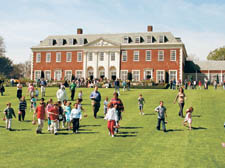|
|
 |
| |
The secret wonder of Woolworths
Martin Sheppard on a piece of US grandeur in Regent’s Park – built for an heiress, but now guarded by armed patrols
Winfield House.
By Maria Tuttle and Marcus Binney.
Thames and Hudson £32.
REGENT'S Park has always been a mixture of public and private. Although far more of the park is open to visitors now than in the 19th century, a number of private villas with their own gardens still exist inside it.
Two are on the Inner Circle: The Holme, whose first owner was the great builder James Burton; and St John’s Villa, until very recently the home of the prodigal Prince Jefri of Brunei.
The privacy of a third villa, on the Outer Circle facing Quinlan Terry’s neo-classical villas, is the most carefully guarded of all, with armed policemen always on patrol.
Winfield House, the home of American ambassadors to the Court of St James since 1954, replaced St Dunstan’s Villa, one of the original villas in the park, which was demolished to make room for it.
It was built for the American heiress Barbara Hutton in 1937 and named after her grandfather, Frank Winfield Woolworth, the founder of the chain store.
She and her architect, Leonard Rome Guthrie, insisted on the use of red brick, despite objections by the Crown Estate.
Used as an RAF club during the Second World War, Barbara Hutton gave it to the US government in 1945.
Neo-Georgian in style, the house has echoes of the work of the 18th-century architect James Gibbs, notably in the stone centrepiece to the garden face. It would not, however, be out of place in Virginia.
Since 1953 its interior has been refurbished by successive ambassadors. As well as providing a London base for visiting presidents, when security reaches fever pitch, the house is used for large-scale entertainment, particularly of Americans in London.
If you have not yet been invited there, Winfield House¸ a lavishly-illustrated book by Maria Tuttle, wife of the current ambassador, and Marcus Binney, the distinguished architectural historian, allows you to make your own tour, including entrée to Barbara Hutton’s bathroom.
The house, set in 12 and a half acres, has an exceptionally fine garden, the second largest in central London and invisible from the main body of the park.
The villa that Winfield House replaced had an even more interesting history. Hertford Villa, designed by Decimus Burton, was built for the third Marquess of Hertford, a notorious rake, in 1825-27. Known as the “Caliph of Regent’s Park”, Hertford was the inspiration for the Marquess of Steyne in Thackeray’s Vanity Fair. Also a principal founder of what long after his death became the Wallace Collection, Hertford changed the name of his villa to St Dunstan’s after buying and installing the clock of the demolished church of St Dunstan’s-in-the-West in Fleet Street in 1829.
Later owned by the financier and philanthropist Otto Kahn, the villa, used during the First World War as a hostel for those who had lost their sight in the fighting, then gave its name to the principal charity for the blind.
|
 |
|
 |
 |
|
 |
|



